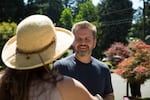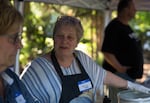Matthew Castor walked the tree-lined streets of his quiet neighborhood in Northeast Portland one sunny Saturday in July.
As he strolled, a pair of his Maywood Park neighbors stopped to bend his ear.
One wanted to warn him about a possible beetle infestation in the neighborhood’s green space. Another neighbor wanted to share his concerns about recent traffic pattern changes the Portland Bureau of Transportation made to Northeast 102nd Avenue, which marks the eastern border of the neighborhood.

Maywood Park Mayor Matthew Castor speaks with a resident while he walks around the city on Saturday, July 20, 2019.
Bryan M. Vance / OPB
On first look, Maywood Park is like many other neighborhoods in east Portland.
It has a suburban vibe: large lots, wide streets, big shady trees, friendly neighbors. Electric scooters are few and far between.
But Maywood Park has one key difference: It’s a city all its own. And Castor is the mayor.
Tucked into the heart of east Portland, the city of Maywood Park was born out of a decade-plus battle to save itself from the jaws of development.
The city within a city
With just over 300 homes and a population well under 1,000, Maywood Park doesn’t feel like a typical city. While it has a city council and a mayor, it lacks its own police force and fire department. There’s no city hall. It doesn’t have a grocery store or cafe.
Why do people choose to live in Maywood Park over the surrounding metropolis of Portland?
“I think that maybe [it’s] accessibility to community government and having some influence over the direction of things,” Castor said.
Brad and Daniel Twiss had a different reason for moving to the city. For them, it was all about the cute ranch house they bought in December 2018. The tight-knit, charming community that came with it was a pleasant surprise.
“We never thought we would be this far east, but it's just like this funky little pocket. It's really cute,” Daniel said.
“I mean, he hardly got me out here,” Brad added, “because it's like you look at the map and it's like the armpit of the freeways.”
Map of Maywood Park
Courtesy of Google Maps
The couple said they can't remember another time they knew all their neighbors by name, not before Maywood Park.
“The friendliness is insane,” Brad said. “And really sweet.”

Brad and Daniel Twiss pose for a portrait in the dining room in their Maywood Park home on Saturday, July 27, 2019, in Maywood Park, Ore.
Bryan M. Vance / OPB
That strong sense of community was forged in a struggle with the state to save the neighborhood more than 50 years ago.
Born out of conflict
Kate Zeller Lamb’s parents bought their house in 1953. Nestled in the heart of the city, it’s a picturesque Maywood Park home, featuring mature landscaping, beautiful architectural flourishes and trees so tall you have to crank your neck to see their tops. Lamb still lives there.
She has fond memories of her childhood in Maywood Park.
Summer nights were spent playing outside until the sun went down. Children roamed the streets freely. Everyone looked out for each other.
“Every dad had a unique whistle" to let their kids know it was time to come home, she said.

Kate Zeller Lamb, a lifelong Maywood Park resident, serves hotdogs at the annual National Night Out event at the Maywood Commons on Saturday, July 27, 2019, in Maywood Park, Ore.
Bryan M. Vance / OPB
But as Lamb tells it, a threat to the community’s quiet way of life emerged in the mid-1960s. The threat came in the form of urban development and it had a name: Interstate 205.
The Oregon Highway Commission wanted to build a new auxiliary highway for Interstate 5 to relieve congestion and speed up commutes to the growing suburbs.
The commission revealed options for the highway's route to the public in the mid-1960s. One of those options called for routing the highway right through the heart of Maywood Park, above grade, taking out dozens of homes in the process.
The residents voiced their displeasure with the plans but felt boxed out of negotiations because they lacked the legal status of other communities involved, such as Lake Oswego, which used its power as a city to nix a proposal to route the highway through its boundaries. That's when the idea to form a city first emerged.
“They said, ‘OK, screw ‘em. We’re going to incorporate and fight ‘em,’” Lamb said of the pioneers of Maywood Park.
It took a few years and two tries, but eventually, Maywood Park citizens approved an initiative to incorporate on Aug. 1, 1967. The collection of homes became its own city in a chunk of unincorporated Multnomah County on the edge of Portland. Two days later, the state highway commission fired back.
"As far as this department is concerned, the route of I-205 is settled," Forest Cooper, an engineer with the Oregon Highway Commission, said bluntly in an Aug. 3, 1967, Oregonian article.
The table was set for a fight. Lamb’s living room served as the staging room.
Lamb's father, Werner Zeller, was a surgeon at Providence Portland Medical Center and served as Maywood Park's first mayor. Lamb remembers the community meeting every Monday in her living room to plan their course of action.
Over the next decade, the city fought tooth and nail to stop the highway. Mothers organized their own traffic and emissions studies, Lamb said. The city sued, first in local and then in federal courts. Their battle made its way all the way to the 9th Circuit Court of Appeals.

A sign warns would-be troublemakers that Maywood Park, Ore., residents are watching.
Bryan M. Vance / OPB
“ODOT thought we were the mouse that kept squeaking,” Lamb said. “These men would not give up.”
In the end, the residents lost their court battles and the highway project moved forward.
A lasting legacy
Interstate 205 now shuttles commuters along a stretch of land where 87 Maywood Park homes once stood. But while the small city may have lost the war, it won some key battles.
"Everyone laughed at Maywood Park thinking [we] didn't do anything, but we did," Lamb's mother, Maxine Zeller, said in an article published in The Oregonian on Sept. 27, 1977.

Residents listen to a band performing at the annual National Night Out event in Maywood Park, Ore., on Saturday, July 27, 2019.
Bryan M. Vance / OPB
You can't see the city from the freeway. That is one of several hard-fought design concessions Maywood Park residents won. The highway in this stretch is well below grade, tucked into a ravine between the city and nearby Rocky Butte. A grassy berm rises high above Maywood Park, providing an extra buffer between it and the highway that nearly wiped it out.
On the other side of that berm is another world. The bustle of the traffic below is replaced with the quiet hum of a community.
“There's all these things that make it feel like small-town America,” Daniel Twiss said.
That includes the annual community yard sale, the neighborhood Fourth of July parade and the Easter egg hunt. Then of course, there’s Halloween.
“I mean you essentially leave your door open and [the trick-or-treaters] just come, and come, and come,” Castor said of one of the city’s biggest cultural events.

People walk along the mixed-use path bordering Interstate 205 inside the city of Maywood Park, Ore., on Saturday, July 20, 2019.
Bryan M. Vance / OPB
It’s all a part of the community that marks life in Maywood Park.
That community isn’t new. It was here before the neighborhood became a city. It grew stronger in the decadelong fight to save Maywood Park from I-205. And it goes strong today.
“It’s always been a close community,” Lamb said. “It’s always been a place where neighbors look out for each other. That’s what’s so wonderful [about living in Maywood Park]: the connections, the community.”

